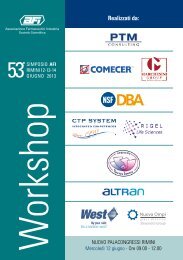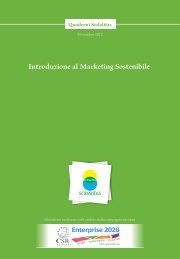NEWS - Altran
NEWS - Altran
NEWS - Altran
Create successful ePaper yourself
Turn your PDF publications into a flip-book with our unique Google optimized e-Paper software.
news<br />
ecOlOGicAl FOOtpRint<br />
THE ADVENT OF ECO-DESIGN<br />
We’ve gone from raising<br />
awareness about eco-design to<br />
taking concrete steps to<br />
implementing it. Soon, we’ll be<br />
embracing eco-design for all<br />
products, as the concept<br />
of sustainable development quickly<br />
diffuses into our code of conduct.<br />
Pr[í]me is a key player in the<br />
campaign to eliminate the<br />
ecological footprint of future<br />
products.<br />
IIt will only take a single generation<br />
for every citizen of a country in<br />
the Western hemisphere to become<br />
his or her own ecologist.<br />
Without a doubt, it will no longer be<br />
merely be a stance for lip service, as<br />
are freedom of speech and gender<br />
equality. Although we must pointedly<br />
seek out eco-designed products<br />
today, we can look forward to<br />
tomorrow, when all products will be<br />
SOCIAL<br />
Fair trade<br />
Sustainable<br />
development<br />
Livable Sustainable<br />
EnvIrOnmEnt<br />
eco-designed. (Who today<br />
thinks twice about<br />
preserving the ozone layer<br />
when buying deodorant?).<br />
So if today is ripe for spreading<br />
awareness, then tomorrow, the ball<br />
will be in the court of designers,<br />
engineers and architects.<br />
However, the current trend in ecodesign<br />
aims at reducing the worst:<br />
reduction of waste, energy used,<br />
toxic products, etc. This philosophy<br />
sees human production as<br />
irrevocably harmful, and we must limit<br />
its maximum impact.<br />
Yet, why not view human products as<br />
a part of nature—who has ever<br />
complained of having too many trees,<br />
earthworms or too much water?<br />
Conceiving a project from design<br />
to end-of-life<br />
The Cradle-to-Cradle theory<br />
(proposed by McDonough and<br />
ECOnOmy<br />
Eco-design =<br />
How?<br />
Braungart in their eponymous book)<br />
suggests treating products<br />
as if they were a temporary stage<br />
in the life cycle of their material<br />
components. Based on this,<br />
they came up with two cycles<br />
applicable to each material<br />
component:<br />
• the biological cycle, whereby<br />
the materials, which are<br />
biodegradable, return to the earth<br />
• the technological cycle, whereby<br />
the materials return to the beginning<br />
of the production chain for reuse<br />
All products belonging to the two<br />
cycles are “hybrids”, cannot truly be<br />
recycled, and end up being<br />
“downcycled”. This is where<br />
the product loses added value in its<br />
following cycle of use, and<br />
eventually ends up in the dump.<br />
So eco-design is supposed to<br />
invent the processing, use and endof-life<br />
of products—it aims at not<br />
just reducing the ecological<br />
footprint, but at eliminating the<br />
concept entirely. Taken with this<br />
approach, eco-design becomes a<br />
never before seen source of<br />
performance and added value.<br />
AltRAn pR[Í]me<br />
AN EVEN GREENER<br />
TRAIN?<br />
ALTRAN PR[í]ME IS WORKING<br />
WITH COMPIN GROUP—<br />
A SPECIALIST IN DESIGN, AMBIANCE<br />
AND COMFORT OF RAILWAY<br />
EqUIPMENT—ON A REVOLUTIONARY<br />
DEVELOPMENT FOR THE TRAIN<br />
OF THE FUTURE. MORE DETAILS<br />
IN THE NExT ISSUE.<br />
sQuARe cOmpOst’<br />
WHO KNEW SORTING<br />
WASTE COULD BE SO<br />
BEAUTIFUL!<br />
eXAmples<br />
SOME PR[í]ME ECO-PRODUCTS<br />
Square Compost’ is a public garden design concept centred<br />
on a new generation composting bin. Each person in a city like<br />
Paris produces 47 kilos of organic waste per year. A green<br />
space of 4,000 m2 surrounding a Square Compost’<br />
mound three metres high and 12 metres in diameter<br />
processes the annual organic waste of 1,600<br />
people. The result of an eco-design approach,<br />
Square Compost’ respects and improves its<br />
environment using innovative technological<br />
solutions. Rainwater is collected and stored,<br />
all components are easy to care for and<br />
easily recyclable, and the entire set-up<br />
is supplied with electricity from Maxxun<br />
solar panels. Underneath the mound is an<br />
ingenious device that decomposes organic<br />
waste in two steps (aerobic, then anaerobic)<br />
in complete safety, with the end result<br />
(solid compost and compost liquid) readily<br />
available to landscapers and individuals to<br />
beautify their gardens.<br />
• Pr[í]me designed Square Compost’ (see above), a neighbourhood waste<br />
composter that provides fertiliser for the garden in which it is placed.<br />
The sorting of community waste makes the children’s playground possible.<br />
• The SplitPack packaging for chilled liquids (see the previous issue)<br />
designed by Pr[í]me separates the carton and the PET so that each<br />
material can undergo its own recycling procedure. The product recycles<br />
ink, glue, varnish and cap.<br />
• The Lufo3W lamp, developed by Pr[í]me for Serras Technologies, uses<br />
the flame’s heat to power a satellite radio, allowing it to spread information<br />
and culture… battery-free!<br />
Contact : serge.roux@altran.com<br />
12 Altitude n°13 / april 2008 Altitude n°13 / april 2008 13








